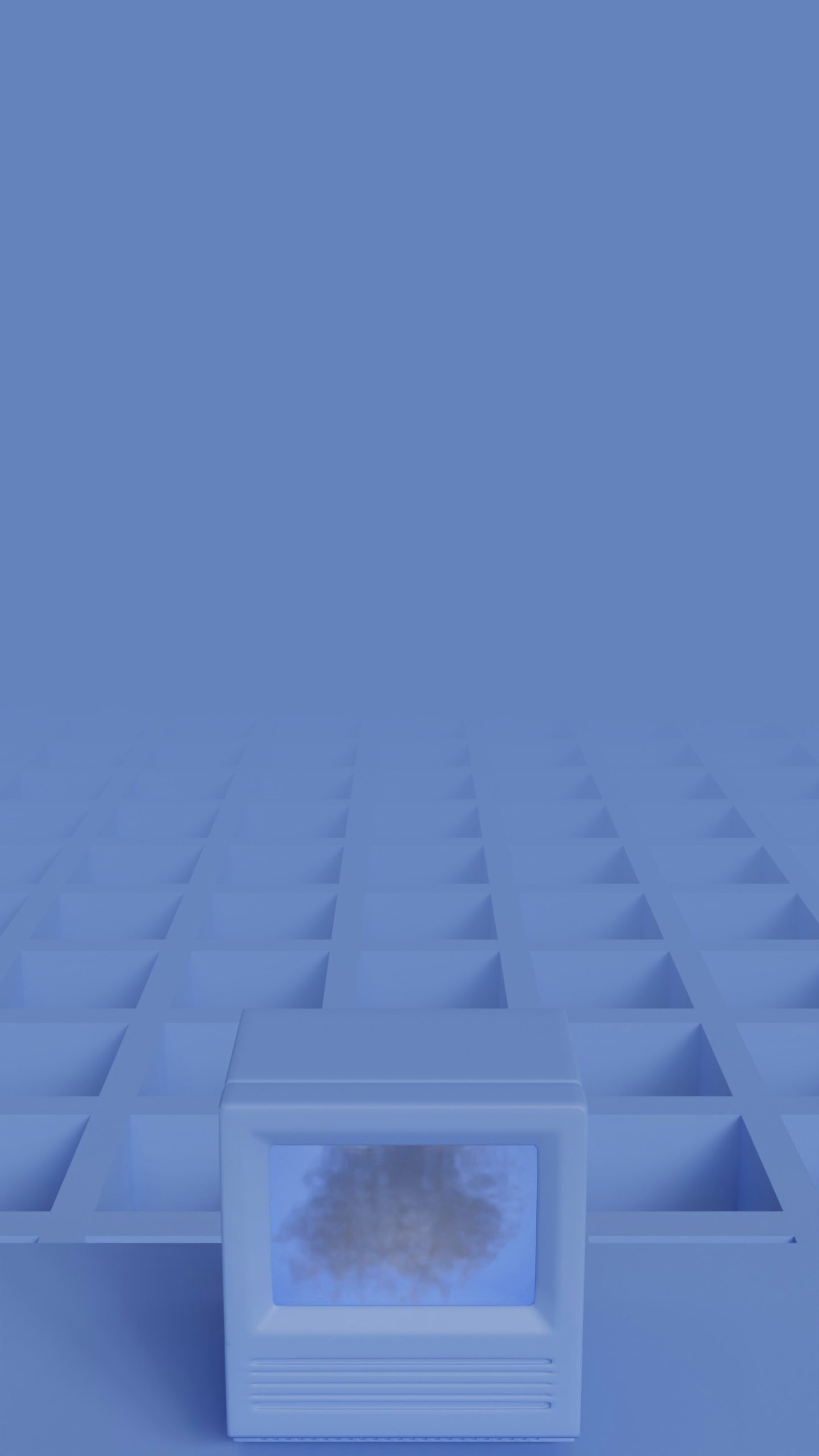
The cyberspace in our backyard and the gardens in our cyberspace

Up in the iCloud, innocent bubbles of data glint under the sun’s heat; from here, they slip frictionlessly into the cool vacuum of space. Adrian Mackenzie describes this new-age phenomena as one of perceived “wirelessness”: the chasmic disconnect between our screens and the moving networks that swell beneath them. With every new release by iPhone or Android in the last decade, phones became less and less wired. What began as cabled and clunky appendages to the early internet broke away from these origins. A world that once sprawled with wires, then became the stomping ground of Bluetooth, wireless charging and airdrop, mediating the space between humans and technology. Now, with the invention of Neuralink, we find ourselves teetering into a cyborgian fantasy of sci-fi nostalgia where technology erodes the biopolitical boundaries of the human body. Here, personal devices are not only severed from their wiry origins, they creep into the fleshy juices of our anatomy. But, despite these mercurial stages of increased ‘wirelessness’, the device’s disembodiment from large scale material systems is ultimately a fantasy.
The iCloud is not a harmless cirrus stratus. It is a collection of titanic, sweaty computers in Central London, Arizona, and Ireland (among others)—tower blocks of data centres that require inordinate amounts of water and air conditioning. But the image of data storage has been constructed subliminally, co-opting our perspective of clouds not only as ecological phenomena but also as objects of aesthetic pleasure and iconographic representatives of the divine. Signal transmission pumps blood through the veins of coaxial cables, fibre optic tubes, cellular towers, air conditioner units, transformers, computer servers, and water pipes. In fact, domestic signal traffic sent within the same land mass will often pass through off coast deep sea cables just to reach its destination. Our internet traffic is sustained by this subterranean and subaquatic cabled infrastructure, an extractive and global organism capable of catastrophic environmental degradation. Is there anything less (i)Cloud than deep sea mining? In essence, there is no comparable process of human activity from which we are so divorced of its accompanying material culture—no other area of cultural life which so effectively erases its landscapes of waste—as our digital world.
When we do think of “trash”, we don’t think about our laptops, the 40,000 photos we have stored on iCloud, or the ten pages of Google search results (the tenth of which fewer people have visited than have climbed Everest), and all of these have an environmental cost. We’ve created more data in the last two years than in all of human history, to the extent that it is now measured in zettabytes. Assuming that on average, one gigabyte is equal to a 65,000 page word document, it would take over 3 trillion trees to print one zettabyte of data and by 2035, we are estimated to have produced around 2000 zettabytes of data. The planet only has 3 trillion trees. Complicating things further, almost half of this internet traffic isn’t wholesome Facebook messages from your aunty—it’s bots. Over 49% of all internet traffic in 2023 was bot-to-bot. It may come as a surprise, but a trashcan for our digital landscape looks less like a cute, pixelated paper-waste bin in the corner of a Mac screen, and a bit more like a room of burning coal with eight air conditioners running at full pump.
The divide between trash and data storage/signal traffic—the former inducing sensory, physical repulsion and the latter floating miles above us in a stratosphere (allegedly)—may seem insurmountable. But whilst mythologies can be slippery and dangerous, particularly in the hands of petrocapitalist corporations, their mercuriality is also an invitation. There are ongoing efforts to (re)materialise the subterranean power structures of data centres and the like in the realms of scholarship (Signal Traffic: Critical Studies of Media Infrastructure,1984; the work of radical anthropologist Steven Gonzalez Monserrate) and art (several pavilions at the Venice Biennale in the past decade). How far reaching and socially constructive theses effort have been, is another matter. However, what I find more exciting is the oblique and alternative ways in which digital spaces themselves are being rewritten. A few months ago, my friend Nick (thanks Nick!) showed me a page called ‘A Website is a Room’, where a regularly updated feed enables users to submit and publish websites that are special to them. The submissions portal calls users to ‘Add New Rooms’, and the original author includes a short introduction about the space:
A Website is a Room: I came to this conclusion sometime during quarantine when I realized that certain websites give me a sense of shelter and rest more than others. These spaces that particularly stood out to me all had some quality of slowness, quiet, and / or gathering. We ought to carefully examine the qualities of the living environment that each web space provides for us.
The interpretation of websites as living environments is reflected in the page’s construction—the typeface’s dependable consistency, the cooling mint background, the “room’s” lucid and focused intention. All these choices contribute to a sense of ease. Crucially, the index maxes out at just under 150 sites, meaning there is no infinite scroll function, a feature which is the real killer when it comes to hyper-addictive apps like Instagram, Facebook, and even Safari. Unlike the perennial house party of strangers that is Instagram, A Website is a Room has a bandwidth. It says, “hey there, this is all I’ve got for you today, it’s more than enough I’m sure, but I’ve got to get some sleep. Besides why would I waste all that energy and signal traffic loading infinite websites when you won’t have the bandwidth to read that many anyway?”
Gerry McGovern would call this good website ‘architecture’. McGovern is one of the leading spokesperson’s for reducing digital waste and he helps organizations to cut back their “data waste” by designing “simpler, lighter, more environmentally friendly websites and apps.” According to McGovern, there’s almost 2 billion websites in the world, but if there was conscious quality control, there’d only be around 100,000: “we are buildings things, in some environments, that are just as big as skyscrapers, just as complex” and without heed for planetary impact or the scope of human need.
A key aspect of A Website is a Room’s uniquely calming effect is also its rejection of the consumptive digital encounter. It rejects the insatiable desire of doom scrolling through its limitation on site number but also through the absence of adverts. There is no implicit or explicit exchange of fungible currency, and this draws us to a crucial overlap between digital encounters and the consumptive gaze. To some extent A Website is a Room is working to unravel the deeply woven bond between digital and capital, positing a new modality of online encounter that counters, not only an unnecessarily expenditure of resources, but also the capitalist aesthetic modality of its first-hand experience. Indeed, the two are inextricably connected and the rise of digital technology was used by capital networks to “break with prior constraints on its expansion,” allowing “commodity relations [to penetrate] previously unexploited segments of social life.” When A Website is a Room offers us a capital-resistant space of calm online, it also offers us a belief in our autonomy over the digital realm; it envisions a radical new future and, for me, that is an inspiring space of activism for the waves of digitally savvy generations who are continually confronted with this monolithic and reductive pessimism about the online world.
This is not intended as a didact, or a vitriol, and I am also wary of placing onus for wide social change in the interior world of individuals, especially whilst corporations are weaponizing the evolutionary wiring of our brains to create, prolong and monetize discontentment. But I also refuse to believe that collective imaginary has zero power against the mass marketing that has fabricated this strange, alternative attitude toward the digital. Why does our experience of a phone rely on the material ‘real’ world any less than the plot of a novel? Why do we see the former as uniquely virtual and ‘unreal’ when humans have been diving into imaginary spaces for years? Can we embody digital encounters? And what positive ramifications might result, on personal, collective and intra-sectionally* ecological levels, from such efforts to remythologise? In her 1994 Reith Lectures Marina Warner described how “patterns of belonging can be fruitfully reformed” and makes a call to rewrite “modern myths”—to use “memory, imagination, language to question, to remember and to repair, to wish things well without sentimentality without rancour, always resisting the sweet seduction of despair.”
I would like to end on another excerpt from A Website is a Room:
Behind each of these kinds of web spaces, there are also individuals who are building them with their own hands. Most websites we visit these days are put up by companies and organizations with complex motivations and incentives. To me, there is a certain beauty in the singular, unobscured intention of an individual who creates a website to share themselves with the world.
Anyways, I’m going to comb through the 400 Chrome tabs I that I have open on my laptop. ∎
*Intra-sectionality is a term coined by T.J. Demos that draws on the work of Karen Barad. It aims at dissolving originary categories of activism in favour of a “political ontology of being-in-relation” and, in Demos’ writing, runs concurrent with a call to urgently “bridge aesthetics and politics.” The article can be found at this link: https://journalpanorama.org/article/ecology-as-intrasectionality/
Words by Isabel Walter. Art by Nikhil Karun.







